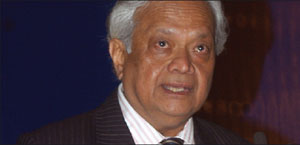India’s accelerator pioneers began to build the Calcutta cyclotron in the early 1970s but soon found that the industrial infrastructure was not geared up to provide the necessary level of technology. They had, for instance, difficulty in finding a suitable manufacturer for the essential resonator tank. The Garden Reach Ship Builders said they could build watertight ships but had no experience in making tanks that had to be airtight, maintaining a high vacuum (10–6 torr). But build it they did, and the cyclotron was commissioned in June 1977. It is still working well and has catered for almost two generations of experimental nuclear physicists.

Image credit: B Sinha, VECC, Kolkata.
In the early 1980s some of us wanted to build a detector to be used at CERN’s SPS to register photons as signals of quark–gluon plasma (QGP), formed in the collision of two nuclei at laboratory energies of typically 200 GeV/nucleon. The protons and neutrons of an atomic nucleus at this energy should “melt” into their fundamental constituents, the quarks and gluons, rather as in the primordial universe a few microseconds after the Big Bang.
The adventure of building a photon multiplicity detector (PMD) was inspiring but not easy. The sheer size and complexity was daunting; the required precision even more so. All of the pundits (i.e. distinguished elderly scientists on funding committees) unanimously declared the project impossible and too ambitious, and generally questioned our credibility. Undaunted, we refused to accept their verdict and against all odds received our initial modest funding.
We did the design in India. The Cyclotron Centre in Calcutta; the Institute of Physics in Bhubaneswar; the universities of Rajasthan and Jammu, and Panjab University joined in. In a short time the group built the PMD, with 55,000 pads, each consisting of a 1–2 cm2 plastic scintillator. Optical fibres inserted diagonally in each pad picked up the photons – the possible signals of QGP.
The PMD was a great success, unprecedented in modern India, particularly on this scale. It required all kinds of creative innovation, with the best suggestions coming from the youngest members of the team. Almost overnight, India became a key player on the world stage in this field. This kind of science and the associated precision technology, which had so far remained dormant, began to flourish; there was no looking back.
The PMD later went through a basic design change with the introduction of a “honeycomb” design, and it was shipped across the Atlantic for the STAR experiment at RHIC at the Brookhaven National Laboratory. With a reputation already established at CERN, entry into RHIC posed no problem whatsoever. The PMD has already accumulated a vast quantity of data at RHIC, with good statistics. Complemented by the results from the PHENIX detector, photons look promising as signals of QGP.
Meanwhile, in India we moved from the room-temperature cyclotron to a superconducting cyclotron using niobium–titanium superconducting wire. Hunting for a suitable company to build our cryostat was an adventure. We searched all of India, but drew a blank. Despite our determination we failed to find a suitable company to build the cryostat, and eventually turned to Air Liquide, France, but not without hiccups. We learned how to manage large-scale liquid helium and maintain a steady liquid helium temperature.
Finally, on 11 January 2005, the magnet became superconducting at a temperature of around 4.2 K and maintained the superconducting state for months. It was a fantastic experience. All of January felt like a carnival. We had made the leap from room-temperature technology to large-scale cryogenic technology.
Meanwhile at CERN, the LHC was looming large on the horizon, with a heavy-ion programme and the ALICE detector. We were thrilled – here was scope for the old workhorse, the PMD, in a more sophisticated guise. Aligarh Muslim University and IIT, Bombay, also joined in our quest. My colleagues at Saha Institute went further, and wanted to participate in the dimuon spectrometer. Colleagues who had remained dormant or busy with routine jobs, were suddenly inspired. They went on to design the MANAS chip for the muon arm. An Indian company, the Semi Conductor Complex Ltd in Chandigarh, enthusiastically offered to build the hardware. After much debate, the MANAS chip became central to the ALICE muon arm and was accepted worldwide.
Last time at CERN, walking in the shadow of ALICE, marvelling at its size and the immaculate precision with which the work was done, I felt like Alice in Wonderland, with “quarkland” beckoning on the horizon.
In the 1970s, India was still a spectator in the world theatre of high science. Individuals who migrated to other parts of the world sometimes excelled. In India, people were proud of them but remained convinced that such feats could not be accomplished back home. In the 1980s, however, there was a major paradigm shift in our mind set. We began to dream of competing with the world from India.
By the beginning of the 21st century, India was no longer a spectator but a significant player on the world stage. The glamour of individual excellence had been replaced by the wisdom of collective effort. We had turned mature and ambitious. What I have presented is a chronicle of that evolution. I am proud and grateful to be a witness and indeed a participant in this evolving panorama.
The voyage that started almost 30 years ago continues with resolve from LHC to FAIR to an ILC and further, making the impossible possible and turning dreams to reality.





